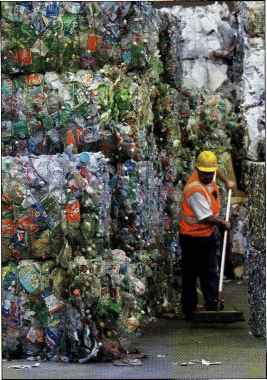Environmentalism
Environmentalist
An organized movement of concerned citizens and government agencies to protect and improve people's current and future living environment.
Whereas consumerists consider whether the marketing system is efficiently serving consumer wants, environmentalists are concerned with marketing's effects on the environment and with the environmental costs of serving consumer needs and wants. Environmentalism is an organized movement of concerned citizens, businesses, and government agencies to protect and improve people's current and future living environment.
Environmentalists are not against marketing and consumption; they simply want people and organizations to operate with more care for the environment. The marketing system's goal, they assert, should not be to maximize consumption, consumer choice, or consumer satisfaction, but rather to maximize life quality. And "life quality" means not only the quantity and quality of consumer goods and services, but also the quality of the environment. Environmentalists want current and future environmental costs included in both producer and consumer decision making.
The first wave of modern environmentalism in the United States, for example, was driven by environmental groups and concerned consumers in the 1960s and 1970s. They were concerned with damage to the ecosystem caused by strip-mining, forest depletion, acid rain, global warming, toxic and solid wastes, and litter. They also were concerned with the loss of recreational areas and with the increase in health problems caused by bad air, polluted water, and chemically treated food.
The second environmentalism wave in the United States was driven by government, which passed laws and regulations during the 1970s and 1980s governing industrial practices impacting the environment. This wave hit some industries hard. Steel companies and
The Environmental Sustainability Portfolio
Source: Stuart L. Hart, "Innovation, Creative Destruction, and Sustainability," Research Technology Management, September-October 2005, pp. 21-27.
Internal
External
Today: Greening
Tomorrow: Beyond Greening
Today: Greening
Tomorrow: Beyond Greening
Internal
External
|
Pollution prevention Eliminating or reducing waste before it is created |
New clean technology Developing new sets of environmental skills and capabilities |
|
Product stewardship Minimizing environmental impact throughout the entire product life cycle |
Sustainability vision Creating a strategic framework for future sustainability |
How does "environmental sustainability" relate to "marketing sustainability"? Environmental sustainability involves preserving the natural environment, whereas marketing sustainability is a broader concept that involves both the natural and social environments—pretty much everything in this chapter.
Environmental sustainability
A management approach that involves developing strategies that both sustain the environment and produce profits for the company.

utilities had to invest billions of dollars in pollution control equipment and costlier fuels. The auto industry had to introduce expensive emission controls in cars. The packaging industry had to find ways to improve recyclability and reduce solid wastes. These industries and others have often resented and resisted environmental regulations, especially when they have been imposed too rapidly to allow companies to make proper adjustments. Many of these companies claim they have had to absorb large costs that have made them less competitive.
The first two environmentalism waves have now merged into a third and stronger wave in which companies are accepting more responsibility for doing no harm to the environment. They are shifting from protest to prevention, and from regulation to responsibility. More and more companies are adopting policies of environmental sustainability. Simply put, environmental sustainability is about generating profits while helping to save the planet. Environmental sustainability is a crucial but difficult societal goal.
Some companies have responded to consumer environmental concerns by doing only what is required to avert new regulations or to keep environmentalists quiet. Enlightened companies, however, are taking action not because someone is forcing them to, or to reap short-run profits, but because it is the right thing to do—for both the company and for the planet's environmental future.
# Figure 20.2 shows a grid that companies can use to gauge their progress toward environmental sustainability. In includes both internal and external "greening" activities that will pay off for the firm and environment in the short run and "beyond greening" activities that will pay off in the longer term. At the most basic level, a company can practice pollution prevention. This involves more than pollution control—cleaning up waste after it has been created. Pollution prevention means eliminating or minimizing waste before it is created. Companies emphasizing prevention have responded with internal "green marketing" programs—designing and developing ecologically safer products, recyclable and biodegradable packaging, better pollution controls, and more energy-efficient operations.
For example, Nike produces PVC-free shoes, recycles old sneakers, and educates young people about conservation, reuse, and recycling. General Mills shaved 20 percent off the paperboard packaging for its Hamburger Helper product, resulting in 500 fewer distribution trucks on the road each year. Sun Microsystems created its Open Work program that gives employees the option to work from home, preventing nearly 29,000 tons of COz emissions, while at the same time saving $67.8 million in real-estate costs and increasing worker productivity by 34 percent. AAnd UPS continues to develop a "green fleet" of alternative-fuel vehicles to replace its old fleet of diesel delivery trucks. In 2009 it will deploy 200 new next-generation hybrid electric delivery vehicles to join the roughly 2,000 low-carbon, hybrid and compressed natural gas vehicles already in use. The hybrid vehicles produce 45 percent better fuel economy and a dramatic decrease in vehicle emissions.22
At the next level, companies can practice product steivardship—minimizing not just pollution from production and product design but all environmental impacts throughout the

- ▲ Pollution prevention: UPS is developing a "green fleet" of alternative-fuel vehicles that produce 45 percent better fuel economy and a dramatic decrease in vehicle emissions.
full product life cycle, and all the while reducing costs. Many companies are adopting design for environment (DFE) and cradle-to-cradle practices. This involves thinking ahead to design products that are easier to recover, reuse, recycle, or safely return to nature after usage, becoming part of the ecological cycle. DFE and cradle-to-cradle practices not only help to sustain the environment, they can also be highly profitable for the company.
An example is Xerox Corporation's Equipment Remanufacture and Parts Reuse Program, which converts end-of-life office equipment into new products and parts. Equipment returned to Xerox can be remanufactured reusing 70 to 90 percent by weight of old machine components, while still meeting performance standards for equipment made with all new parts. The program creates benefits for both the environment and for the company. So far, it has diverted nearly two billion pounds of waste from landfills. And it reduces the amount of raw material and energy needed to produce new parts. Energy savings from parts reuse total an estimated 320,000 megawatt hours annually—enough energy to light more than 250,000 homes for a year.23
Today's "greening" activities focus on improving what companies already do to protect the environment. The "beyond greening" activities identified in Figure 20.2 look to the future. First, internally, companies can plan for new clean technology. Many organizations that have made good sustainability headway are still limited by existing technologies. To create fully sustainable strategies, they will need to develop innovative new technologies. A For example, Coca-Cola is investing heavily in research addressing many sustainability issues:24
From a sustainability viewpoint for Coca-Cola, an aluminum can is an ideal package. Aluminum can be recycled indefinitely. Put a Coke can in a recycling bin, and the aluminum finds its way back to a store shelf in about six weeks. The trouble is, people prefer clear plastic bottles with screw-on tops. Plastic bottles account for nearly 50 percent of Coke's global volume, three times more than aluminum cans. And they are not currently sustainable. They're made from oil, a finite resource. Most wind up in landfills or, worse, as roadside trash. They can't be recycled indefinitely because the plastic discolors. To attack this waste problem, Coca-Cola will invest about $44 million to build the world's largest state-of-the-art plastic-bottle-to-bottle recycling plant. As a more permanent solution, the company is researching new ideas like bottles made from corn or bioplastics.
Coke is also investing in new clean technologies to solve other environmental issues. For example, about ten million or so vending machines and refrigerated coolers use potent greenhouse gases called HFCs to keep Cokes cold. To eliminate them, the company invested $40 million in research and formed a refrigeration alliance with McDonald's and even competitor PepsiCo. Coca-Cola has also promised to become "water neutral" by researching ways to help its bottlers waste less water and ways to protect or replenish watersheds around the world.
Finally, companies can develop a sustainability vision, which serves as a guide to the future. It shows how the company's products and services, processes, and policies must evolve and what new technologies must be developed to get there. This vision of sustainability provides a framework for pollution control, product stewardship, and new environmental technology for the company and others to follow.
Most companies today focus on the upper-left quadrant of the grid in Figure 20.2, investing most heavily in pollution prevention. Some forward-looking companies practice product stewardship and are developing new environmental technologies. Few companies have well-defined sustainability visions. However, emphasizing only one or a few quadrants in the environmental sustainability grid can be shortsighted. Investing only in the left half of the grid puts a company in a good position today but leaves it vulnerable in the future. In contrast, a heavy emphasis on the right half suggests

- A New clean technologies: Coca-Cola is investing heavily to build a state-of-the-art plastic-bottle-to-bottle recycling plant. It's also researching new alternatives such as bottles made from corn or bioplastics.
that a company has good environmental vision but lacks the skills needed to implement it. Thus, companies should work at developing all four dimensions of environmental sustainability.
Wal-Mart, for example, is doing just that. Through its own environmental sustainability actions and its impact on the actions of suppliers, Wal-Mart has emerged in recent years as the world's super "eco-nanny." Alcoa, the world's leading producer of aluminum, is also setting a high sustainability standard. For four years running it has been named one of the most sustainable corporations in the annual Global 100 Most Sustainable Corporations in the World ranking:
Alcoa has distinguished itself as a leader through its sophisticated approach to identifying and managing the material sustainability risks that it faces as a company. From pollution prevention via greenhouse gas emissions reduction programs to engaging stakeholders over new environmental technology, such as controversial hydropower projects, Alcoa has the sustainability strategies in place needed to meld its profitability objectives with society's larger environmental protection goals. . . . Importantly, Alcoa's approach to sustainability is firmly rooted in the idea that sustainability programs can indeed add financial value. Perhaps the best evidence is the company's efforts to promote the use of aluminum in transportation, where aluminum—with its excellent strength-to-weight ratio—is making inroads as a material of choice that allows automakers to build low-weight, fuel-efficient vehicles that produce fewer tailpipe emissions. This kind of forward-thinking strategy of supplying the market with the products that will help solve pressing global environmental problems shows a company that sees the future, has plotted a course, and is aligning its business accordingly. Says CEO Alain Belda, "Our values require us to think and act not only on the present challenges, but also with the legacy in mind that we leave for those who will come after us ... as well as the commitments made by those that came before us."25
Environmentalism creates some special challenges for global marketers. As international trade barriers come down and global markets expand, environmental issues are having an ever-greater impact on international trade. Countries in western Europe, North America, and other developed regions are generating strict environmental standards. The European Union has passed "end-of-life" regulations affecting automobiles and consumer electronics products. And the EU's Eco-Management and Audit Scheme (EMAS) provides guidelines for environmental self-regulation. In the United States, for example, more than two dozen major pieces of environmental legislation have been enacted since 1970, and recent events suggest that more regulation is on the way. A side accord to the North American Free Trade Agreement (NAFTA) set up the Commission for Environmental Cooperation resolving environmental matters.26
However, environmental policies still vary widely from country to country. Countries such as Denmark, Germany, Japan, and the United States have fully developed environmental policies and high public expectations. But major countries such as China, India, Brazil, and Russia are in only the early stages of developing such policies. Moreover, environmental factors that motivate consumers in one country may have no impact on consumers in another. For example, PVC soft-drink bottles cannot be used in Switzerland or Germany. However, they are preferred in France, which has an extensive recycling process for them. Thus, international companies have found it difficult to develop standard environmental practices that work around the world. Instead, they are creating general policies and then translating these policies into tailored programs that meet local regulations and expectations.
Continue reading here: Sustainable Marketing Principles
Was this article helpful?
Readers' Questions
-
pekka1 year ago
- Reply
-
carol1 year ago
- Reply